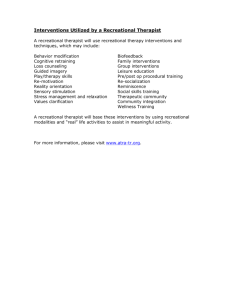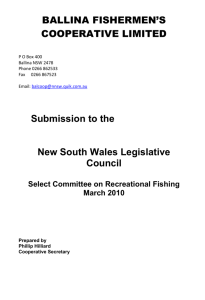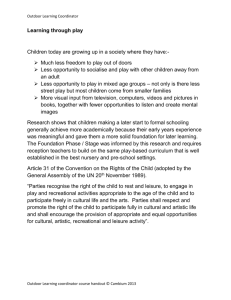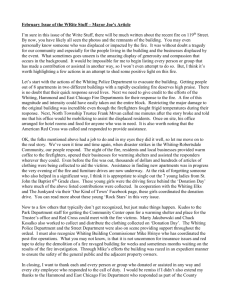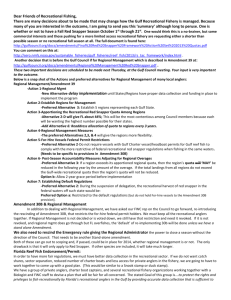Management of the King George Whiting Fishery
advertisement
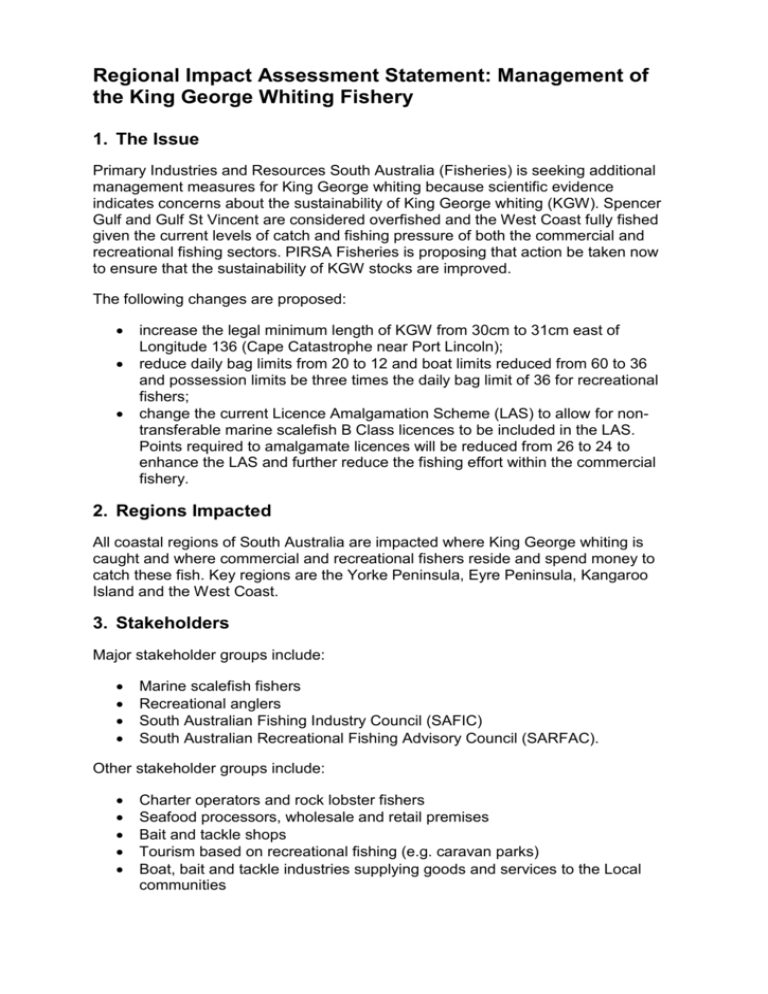
Regional Impact Assessment Statement: Management of the King George Whiting Fishery 1. The Issue Primary Industries and Resources South Australia (Fisheries) is seeking additional management measures for King George whiting because scientific evidence indicates concerns about the sustainability of King George whiting (KGW). Spencer Gulf and Gulf St Vincent are considered overfished and the West Coast fully fished given the current levels of catch and fishing pressure of both the commercial and recreational fishing sectors. PIRSA Fisheries is proposing that action be taken now to ensure that the sustainability of KGW stocks are improved. The following changes are proposed: increase the legal minimum length of KGW from 30cm to 31cm east of Longitude 136 (Cape Catastrophe near Port Lincoln); reduce daily bag limits from 20 to 12 and boat limits reduced from 60 to 36 and possession limits be three times the daily bag limit of 36 for recreational fishers; change the current Licence Amalgamation Scheme (LAS) to allow for nontransferable marine scalefish B Class licences to be included in the LAS. Points required to amalgamate licences will be reduced from 26 to 24 to enhance the LAS and further reduce the fishing effort within the commercial fishery. 2. Regions Impacted All coastal regions of South Australia are impacted where King George whiting is caught and where commercial and recreational fishers reside and spend money to catch these fish. Key regions are the Yorke Peninsula, Eyre Peninsula, Kangaroo Island and the West Coast. 3. Stakeholders Major stakeholder groups include: Marine scalefish fishers Recreational anglers South Australian Fishing Industry Council (SAFIC) South Australian Recreational Fishing Advisory Council (SARFAC). Other stakeholder groups include: Charter operators and rock lobster fishers Seafood processors, wholesale and retail premises Bait and tackle shops Tourism based on recreational fishing (e.g. caravan parks) Boat, bait and tackle industries supplying goods and services to the Local communities Local Councils 4. Consulted Parties Recreational fishers through South Australian Recreational Fishing Advisory Council Commercial marine scalefish fishers through South Australian Fishing Industry Council State Government South Australian Research and Development Institute (SARDI) scientists District Councils on Yorke Peninsula and Kangaroo Island Marine Scalefish Fishery Management Committee 5. Consultation The Marine Scalefish Fishery Management Committee (MSFMC) is the statutory body that provides advice to the Minister for Agriculture, Food and Fisheries. The MSFMC is a co-management committee made up of representatives from the major stakeholder groups who provide their expertise in The MSFMC has consulted widely through its representatives about the various management options available to improve the sustainability of King George whiting. The MSFMC established a King George Whiting Working Group made up of MSFMC members and scientists to review the information available, review options and provide advice to the MSFMC. Key stakeholder groups, the South Australian Recreational Fishing Advisory Committee, the peak recreational body, had canvassed widely throughout South Australia concerning their input into the management options as did the South Australian Fishing Industry Council that represents marine scalefish fishers. Correspondence was received from the general public on the management of King George whiting which was taken into account in the formulation of key options. The South Australian Research and Development Institute scientists were consulted throughout the option development process to ensure that the best management options for rebuilding the King George whiting stocks were based on the best available scientific information. The following consultation process was undertaken for the introduction of changes to the management of King George whiting, The MSFMC has held meetings during the last 12 months to discuss the management of the King George whiting fishery. The KGWWG met four times during 2003/04 to review scientific report and stock assessments on King George whiting. The MSFMC reviewed the findings of the KGWWG and determined the new biological reference points necessary for the rebuilding of King George whiting stocks. The MSFMC advised the Minister that there were sustainability concerns for King George whiting within Spencer Gulf and Gulf St Vincent and made recommendations including size limits, bag and boat limits. The Minister over the last two years has received numerous letters and submissions concerning the sustainability of King George whiting from local government, community groups and individuals. The Director of Fisheries, Principal Fisheries Manager and the Manager of the Marine Scalefish Fishery have attended public meetings at Coobowie, Stansbury and Minlaton and the Yorke Peninsula District Council and Kangaroo Island District Council to listen to public concerns about the marine scalefish fishery including King George whiting and commercial netting. 6. Summary of Impacts The proposed amendments are in pursuit of the objectives of Section 20 of the Fisheries Act 1982. Specifically, the introduction of new minimum size limits, bag and boat limits and possession limits will significantly contribute to the long-term biological sustainability of KGW. The purpose of the amended regulation is to rebuild KGW stocks to sustainable levels for future generations. 1.1. Economic Factors The regional impact of the proposed amendments will on balance be positive. The changes in the size limits may have initial regional impacts due to reduced localised recreational catches and commercial catches in some Upper Gulf areas until the King George whiting population adjusts to the size limit changes. However, the longterm sustainability of KGW is an integral component of vibrant regional recreational tourism. The impacts on small business associated with the proposed amendments relate to any changes to recreational fishing tourism that may impact on visitation at caravan parks and local stores dependent on fishing related expenditure. The benefits for these same firms that will be derived from the improved sustainability of the fishery should offset the initial impacts in the medium to long term. 1.2. Social factors The proposed amendment will have an impact of families of the commercial fishers who may have reduced catches for 18 months as a result of the size limit changes within Spencer Gulf and Gulf St Vincent. The northern areas of both Gulfs have smaller sized fish and the catch will therefore be less under the new rules. Under the proposed arrangements, stock recovery is expected within 3 to 5 years, with change being able to be meaningfully assessed within 3 years. For the recreational fishery, anglers may have less fish available to them as a result of the revised bag limits and the increase in size limits. In some areas there maybe less recreational opportunities for KGW, but other species are available to these fishers. 1.3. Environmental Factors All environmental impacts will be positive. 7. Mitigation The negative impacts and potential backlash from the proposal have been mitigated by a consultation process that has promoted the medium to long term benefits to commercial and recreational fishers that will be derived from the improved sustainability of the fishery. PIRSA Fishwatch has a risk management strategy that will take into account the proposed changes. The adoption of the changes reduces the risk of overfishing. 8. Coordination PIRSA Fisheries will coordinate a broad community consultation and awareness program to ensure cost effective implementation of the new management measures. Local government will be informed of changes by PIRSA and the MSFMC will be involved in public meetings. The peak representative bodies will act as information sources on the new regulation. All fisheries signage on wharfs, jetties and boat ramps will be amended to display new arrangements from 1 October 2004. 9. Preferred Option PIRSA Fisheries has fully considered the following alternative options 1.4. Increase Legal Minimum Limit from 30cm to 32cm Benefits: Meets biological objectives for rebuilding KGW stocks. Risks: Hardships to marine scalefish fishers with less access to KGW numbers greater than 32cm in the upper areas of Spencer Gulf, Gulf St Vincent, Adelaide metropolitan area and the Kangaroo Island - investigator Strait areas moving to other areas causing conflicts with recreational anglers and other commercial fishers; Economic and social flow-on effects to coastal communities of less fish being available to recreational and commercial fishers. Tourism could be affected through less demand from anglers going elsewhere. Supply of fresh fish to local communities could be reduced. Higher release rates and potential mortality of KGW from anglers and commercial netting operations. 1.5. Increase Legal Minimum Length from 30cm to 31cm, recreational bag limits reduced from 20 to 12, boat limits reduced from 60 to 36 and possession limits of 24 per person. Benefits: Meets biological objectives for rebuilding KGW stocks. Risks: Some hardships to marine scalefish fishers with less access to KGW numbers greater than 31cm moving to other areas causing conflicts with recreational anglers and other commercial fishers; Economic and social flow-on effects to coastal communities of less fish being available. Higher release rates and potential mortality of KGW. Tourism impacts in some areas. Upon consideration of the benefits and risks of these two key alternative, the preferred option was: 1.6. Preferred Option Increase Legal Minimum Length from 30cm to 31cm east of Longitude 1360 (Cape Catastrophe near Port Lincoln), recreational bag limits reduced from 20 to 12, boat limits reduced from 60 to 36 and possession limits of 24 per person. Benefits: Meets biological objectives for rebuilding KGW stocks. Reduced social and economic impacts for the West Coast Risks: Some hardships to marine scalefish fishers with less access to KGW numbers greater than 31cm east of Longitude 1360 (Cape Catastrophe near Port Lincoln) in the Gulfs and moving to other areas causing conflicts with recreational anglers and other commercial fishers; Economic and social flow-on effects to coastal communities of less fish being available. Higher release rates and potential mortality of KGW. Tourism impacts in some areas.




